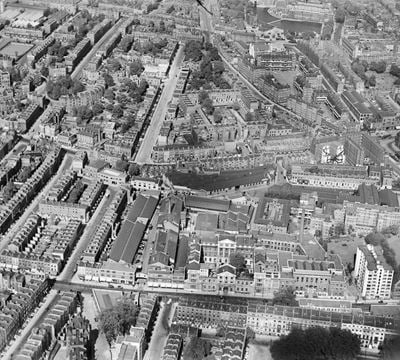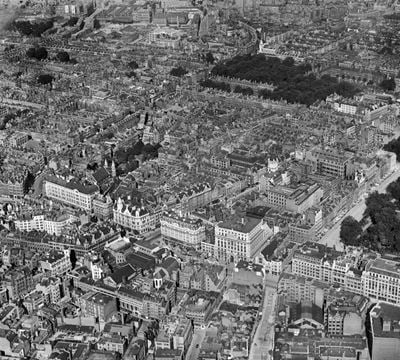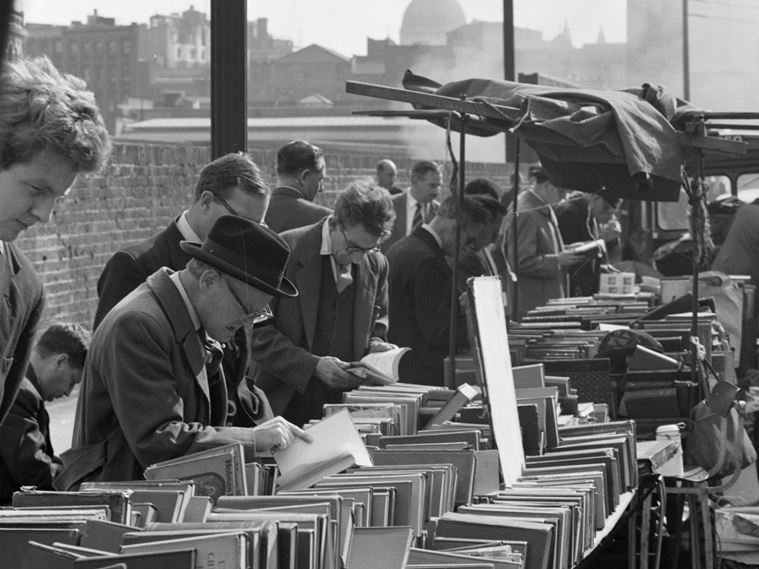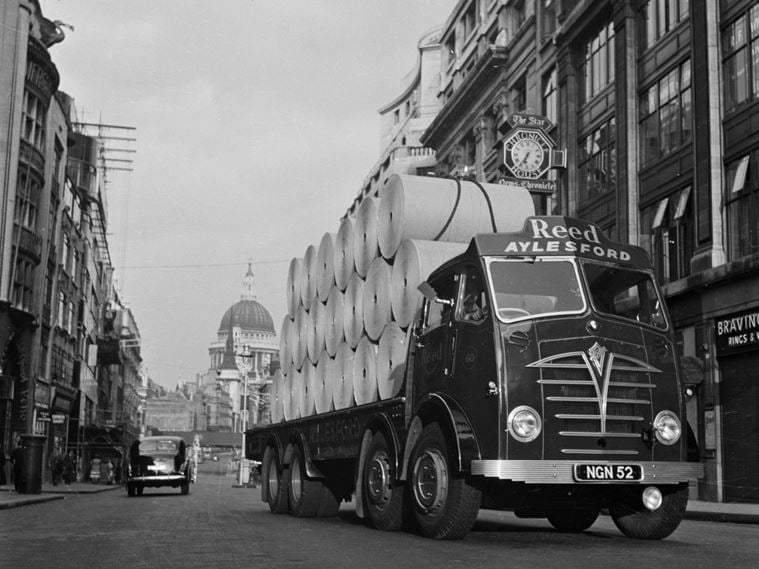Camden
Explore hidden histories, historic photos, and things you never knew about Camden from the collections and archives of Historic England.
Discover your local listed buildings and places
Introducing some of Camden's most historic sites, included in the National Heritage List for England. Some of these captions have been summarised by AI. Click through for the official List entry. Skip this section and go to place by numbers
Bell Barrow called Boadicea's Grave, 650m west of Millfie…
Camden
Known in local folklore as 'Boadicea's Grave,' this scheduled monument is near the top of Parliament Hill, London.
Tomb of Mary Wollstonecraft, William Godwin and Mary Jane…
Camden
This tomb in St Pancras Old Church Garden, Camden, includes inscriptions for the writers and radical philosophers Mary Wollstonecraft and William Godwin.
The Light House, including hard landscaping and summer ho…
Camden
Post-Modern house with hard landscaping and summer house to the garden, designed in 1983 and built between 1984 and 1985 to designs by architect Ivan Simovic for his family.
Lilian Baylis House (former Decca recording studios), inc…
Camden
Former Crystalate and Decca recording studios, built as the Falcon Works in 1884.
Former Police Station and Courthouse, including stable an…
Camden
Former Police Station and Courthouse, including stable and harness room, railings and lamps, 1913, by John Dixon Butler, surveyor to the Metropolitan Police.
Friends House, and Drayton House, with walls, railings, a…
Camden
Quaker meeting house with central offices and library of the Quakers in Britain, built in 1924-8 in neo-Georgian style to the design of Hubert Lidbetter.
Dunboyne Road Estate
Camden
Public housing, 1971-77, to designs of 1966 by Neave Brown of the London Borough of Camden's Architects' Department. Minor later alterations. Read the official list entry to find out more.
Philips Building, School of Oriental and African Studies
Camden
University Library for the School of Oriental and African Studies.
Former Saville Theatre
Camden
Cinema converted from theatre, built 1930-1931 to the designs of T P Bennett & Son in collaboration with the theatre architect Bertie Crewe with sculptural frieze and roundels by Gilbert...
St Pancras Station and Former Midland Grand Hotel
Camden
St Pancras Station and the former Midland Grand Hotel, designed by George Gilbert Scott, is a notable example of Gothic Revival architecture, blending historical and cultural significance.
The Triplet (Gasholder Nos 10, 11 and 12), King’s Cross
Camden
Three conjoined gasholder guide frames originally built in 1879 to 1880 (replacing earlier frames of 1861, 1864 and 1867) to the design of the engineer John Clark by the contractor Westwood...
Space House (now Civil Aviation Authority House)
Camden
Speculative office development, 1964-8 by Richard Seifert & Partners (partner-in-charge George Marsh) for Harry Hyams. Read the official list entry to find out more.
The British Library, piazza, boundary wall and railings t…
Camden
Public Library, the present design based on that of 1975-8, built 1982-99, though opened in 1997; architect Sir Colin St John Wilson, with M.J.
Centre Point
Camden
Offices, flats and shops complex built 1961-66Designed by Richard Seifert and Partners for the developer Harry Hyams; leading design partner George Marsh.
Branch Hill Estate
Camden
Twenty-one semi-detached houses, 1974-6, by Gordon Benson and Alan Forsyth of the London Borough of Camden's Architects' Department. Minor later alterations.
The British Museum King Edward VII Galleries and Attached…
Camden
**Summary of Importance:** The British Museum's King Edward VII Galleries, designed by Sir John Burnet, feature an Edwardian Beaux Arts facade with iconic Ionic columns and carved stone...
Kings Cross Station
Camden
Designed by Lewis Cubitt and opened in 1852, King's Cross Station is England's largest intact terminus, showcasing a distinctive contrast to nearby St Pancras.
Lincoln's Inn Fields
Camden
Lincoln's Inn Fields evolved from a chaotic public square into a formal garden, hosting historic structures, lined by mature trees and memorial sites, surrounded by varied architectural...
The Elephant House Including Former Coopers' Building, Bo…
Camden
Former bottle store, coopers' building and boundary walls. 1900-1 by William Bradford for the Camden Brewery. Minor later alterations. Read the official list entry to find out more.
No. 30 Euston Square and attached railings (formerly 1-9 …
Camden
Offices, built 1906-8 as the headquarters of the London, Edinburgh and Glasgow Assurance Company. Architect A Beresford Pite.
Acland Burghley School
Camden
Secondary school by Howell, Killick, Partridge and Amis 1963-7. Read the official list entry to find out more.
Tomb of Sir John Soane, His Wife and Son in St Pancras Ol…
Camden
The Tomb of Sir John Soane, designed in 1816, influenced the design of iconic British telephone boxes by Giles Gilbert Scott.
Bedford Square
Camden
Bedford Square, designed by Thomas Leverton, features Georgian architecture and enclosed gardens. Notable residents included H.H. Asquith and William Butterfield.
Numbers I, 1A, 1B, 1C and 1D and 2-32 Isokon Flats
Camden
The Isokon Flats, designed by Wells Coates for Jack and Molly Pritchard, were built in 1933-34.
No 6 Denmark Street
Camden
Terraced house of c1690, converted to retail use on the ground floor and office use above. Some C18, C19 and C20 alterations.
35 and 37 New Oxford Street
Camden
Terrace of shops and former offices or chambers, now studio flats.
Church of St Pancras
Camden
The Church of St Pancras, built between 1819-22, is London's earliest Greek Revival church, designed by H and HW Inwood, with Greek influences from the Erechtheum, Athens.
No. 78 South Hill Park
Camden
Private house by Brian Housden for himself and his family, designed from 1958 onwards, and built 1963-65. Read the official list entry to find out more.
Nos. 80-90 South Hill Park (evens)
Camden
Nos. 80-90 South Hill Park is a terrace of six houses, built 1954-6 to the designs of Stanley Amis and William and Gillian Howell, for themselves and four other families.
Kenwood House (Iveagh Bequest)
Camden
Kenwood House holds historical significance for its connection to Lord Mansfield and Dido Elizabeth Belle, highlighting key moments in the history of Black presence and legal battles against...
Hopkins House
Camden
House, built by Michael and Patty Hopkins for themselves and their family in 1975-6. It also served as their offices until the mid-1980s. Structural engineer Tony Hunt.
Primrose Hill
Camden
Primrose Hill, added to Regent's Park in 1841, evolved from farmland into public park space, playing a significant role in public events and recreation.
The Interchange on North Side of Grand Union Canal Includ…
Camden
Warehouse. Built 1901-5 but incorporating 1850s dock basin, vaults and horse tunnel. Warehouse converted into offices in 1989. Read the official list entry to find out more.
6 Gainsborough Gardens
Camden
Detached villa, 1885 by HS Legg for Thomas Clifford, leasee, as part of the development of Gainsborough Gardens between 1882 and 1895.
Russell Square Underground Station
Camden
One of the most impressive surviving Leslie Green underground stations, including a largely intact faience facade retaining original tiled lettering.
Explore more
Search for more listed placesCamden through time
This timeline shows the first period of use for buildings and places on the National Heritage List for England, just one of the details recorded for every list entry. Click around to see how Camden changes over time. Skip this section and go to aerial photos
Prehistoric Before AD 43
Prehistory covers a million years of human occupation before the Roman invasion, from hunter-gatherers of several human species, including Neanderthals, to more recent herders and farmers. It was a time of developing technologies and belief systems, involving contact with and migration from Europe, all reflected in the variety of artefact and monument types characteristic of particular prehistoric periods.
Early medieval AD 410 to AD 1066
This period, often associated in England with Anglo-Saxons and Vikings, saw a reduction in urban living from the Roman period and increased migration from northern Europe.
Traces of this period can be found in cemeteries, particularly in artefacts and in some of the very early churches, as this period also saw the growth of Christianity in Britain.
Medieval AD 1066 to AD 1540
This period, sometimes known as the Middle Ages, began with the Norman invasion in AD 1066. It saw a significant rise in military and defensive buildings such as castles and earthworks, as well as religious houses dominating a largely agricultural landscape.
The monarchy and Church dominated the period, which also saw the break with the Roman Catholic Church and the English reformation.
Post medieval AD 1540 to AD 1901
The Post-Medieval period brought seismic changes to life in England, with religious reformation leading to the democratization of worship and the destruction of hundreds of religious houses.
In parallel, there was a huge expansion of scientific study and enlightenment that permanently altered the nation's social structure and landscape. Industrialization and mass production lead to wider global trade, emigration, and immigration.
20th century AD 1901 to AD 2000
The 20th century saw an incredible expansion of England's transport networks, with suburban growth shadowing rapid infrastructural expansion. The establishment of state schools, hospitals, and modern technical colleges, with new architectural styles, radically changed the appearance of towns and cities.
Two catastrophic world wars and the 1918 pandemic also brought unprecedented change, altering England's built environment and social structures forever.
Prehistoric Before AD 43
Prehistory covers a million years of human occupation before the Roman invasion, from hunter-gatherers of several human species, including Neanderthals, to more recent herders and farmers. It was a time of developing technologies and belief systems, involving contact with and migration from Europe, all reflected in the variety of artefact and monument types characteristic of particular prehistoric periods.
Early medieval AD 410 to AD 1066
This period, often associated in England with Anglo-Saxons and Vikings, saw a reduction in urban living from the Roman period and increased migration from northern Europe.
Traces of this period can be found in cemeteries, particularly in artefacts and in some of the very early churches, as this period also saw the growth of Christianity in Britain.
Medieval AD 1066 to AD 1540
This period, sometimes known as the Middle Ages, began with the Norman invasion in AD 1066. It saw a significant rise in military and defensive buildings such as castles and earthworks, as well as religious houses dominating a largely agricultural landscape.
The monarchy and Church dominated the period, which also saw the break with the Roman Catholic Church and the English reformation.
Post medieval AD 1540 to AD 1901
The Post-Medieval period brought seismic changes to life in England, with religious reformation leading to the democratization of worship and the destruction of hundreds of religious houses.
In parallel, there was a huge expansion of scientific study and enlightenment that permanently altered the nation's social structure and landscape. Industrialization and mass production lead to wider global trade, emigration, and immigration.
20th century AD 1901 to AD 2000
The 20th century saw an incredible expansion of England's transport networks, with suburban growth shadowing rapid infrastructural expansion. The establishment of state schools, hospitals, and modern technical colleges, with new architectural styles, radically changed the appearance of towns and cities.
Two catastrophic world wars and the 1918 pandemic also brought unprecedented change, altering England's built environment and social structures forever.
Aerial photos of Camden
Aerial photography helps reveal secrets of England's changing landscapes that are impossible to see from the ground. Skip this section and go to archive images

Hampstead Heath
Kenwood House, Hampstead Heath, 1920

Hampstead Heath
Kenwood House, Hampstead Heath, 1938

St Pancras
The Royal Free Hospital, Kelvinator Ltd Works and environs, St Pancras, 1939

St Pancras
Mecklenburgh Square Gardens and Gray's Inn Road, St Pancras, 1947

St Giles
High Street and environs, St Giles, London, 1920

Bloomsbury
British Museum, looking towards St Pancras Station, London, 1966

Holborn
Gray's Inn and environs, London, 1920

Holborn
Holborn, Lincoln's Inn Fields and the surrounding city, Holborn, 1952

Holborn
Kingsway and environs, Holborn, 1928

Holborn
Holborn, High Holborn and the surrounding city, Holborn, 1952
Camden in the Historic England Archive
The Historic England Archive cares for over 15 million images, dating from the 1850s to the present day. Discover stunning images of Camden's past. Skip this section and go to stories about heritage
Charles George Harper Collection
Holborn, City Of Westminster, Greater London Authority
Date created: 1892 - 1933
The Old Curiosity Shop on Portsmouth Street, with a man standing on the street outside
Eric de Mare
Camden, Greater London Authority
Date created: 1945 - 1967
Exterior view of the Round House in Camden Town, before conversion into a theatre, with cars in front.
John Gay Collection: London
Primrose Hill, Camden, Greater London Authority
Date created: 1950 - 1965
The 'modern' reception area of the English Folk Dance and Song Society at Cecil Sharp House, named after the man who led the English folk music...
John Gay Collection: Highgate and Hampstead
Highgate, Camden, Greater London Authority
Date created: Spring 1995
Graves in an overgrown part of the West Cemetery
John Gay Collection: Modern Architects
Gospel Oak, Camden, Greater London Authority
Date created: 1978
The interior of the library at Gospel Oak looking through an internal doorway into the main library area with a display of childrens books to the side
John Gay Collection: Rural Life
Hampstead Heath, Camden, Greater London Authority
Date created: 1940 - 1950
Winter trees in the snow, Hampstead Heath
John Gay Collection: Advertising and Promotional Photographs
Hampstead Heath, Camden, Greater London Authority
Date created: May 1947
Youngsters playing at the children's playground on Parliament Hill Fields
John Gay Collection: Miscellaneous
Camden, Greater London Authority
Date created: 1950s
A young boy looking out of a window
John Gay Collection: Counties
Camden, Greater London Authority
Date created: 1950s - 1960s
Looking across the lake towards an evening open air concert in the grounds of Kenwood House
John Laing Collection
St Pancras, Camden, Greater London Authority
Date created: circa 1997 - 1998
Interior view of the British Library
London, Midland and Scottish Railway Company
Kentish Town, Camden, Greater London Authority
Date created: 27 Jul 1931
The scrubbers and condensers at Highgate Road Oil and Gas Works
Nigel Temple Collection of Postcards of Parks and Gardens
Golders Hill Park, Camden, Greater London Authority
Date created: 1900 - 1930
GENERAL VIEW OF LAKE LOOKING TOWARDS BRIDGE
Stories about heritage in your local area
Historic England publishes news, blogs, research, videos, and podcasts celebrating England's rich heritage. Discover the stories we have about Camden. Skip this section and go to education
A Brief Introduction to Semi-Detached Housing
Mentions Numbers 2-16, 22-34, 36A and 36B and Attached Railings, St Pancras Station and Former Midland Grand Hotel
Semi-detached housing is the most prevalent type of housing in England today, making up one third of the housing stock.
Groundbreaking English Women of Science
Mentions Elizabeth Garrett Anderson Hospital
Discover the lives of women who impacted scientific discoveries in England's history, such as Marie Stopes and codebreaker Joan Clarke.
6 Places Connected to Queer Jewish History in London
Mentions Numbers 25-29 and Attached Railings and Lamp Holder
Discover the places connected to queer Jewish history in London including Hyde Park, Gateways Club in Chelsea, and the Colony Room Club.
Boudica’s Revolt Against Rome
Mentions Bell Barrow called Boadicea's Grave, 650m west of Millfield Cottage
Discover the life of Boudica, or Boadicea, the Warrior Queen and leader of the Iceni tribe
The Buildings of Architect Ernő Goldfinger
Mentions 1, 2 and 3, Willow Road
Discover the modernist buildings of Hungarian-born architect Ernő Goldfinger, including Trellick Tower, Balfron Tower and 2 Willow Road.
A Brief Introduction to Cabmen’s Shelters
Mentions Cabmen's Shelter
Discover the history of the small green cabmen's shelters in London that still serve the capital's taxi drivers
7 Serene Cemeteries to Visit in England
Mentions Highgate Cemetery
These graveyards can offer space for quiet reflection or a peaceful walk.
Narrative Structures: England’s Literary History in 11 Places
Mentions The British Museum, Charles Dickens House and Attached Railings
Discover the historic sites in England where famous writers found their inspiration.
Where Handel Meets Hendrix: London’s Musical History in 7 Places
Mentions The Roundhouse
Famous musicians have lived and worked in and around London for hundreds of years.
Why Exercising in Historic Green Spaces is Good for Your Mental (and Physical) Health
Mentions Alexandra Road Park
Explore the benefits of historic public parks and green spaces across England.
007 Historic Places Behind the World of James Bond
Mentions 1, 2 and 3, Willow Road
Explore some of the listed places that helped to build Bond’s world.
A Guide to English Gothic Architecture
Mentions Roman Catholic Church of St Etheldreda and Attached Walls and Piers
Learn how to identify the features and characteristics of medieval Gothic architecture in England.
Sustaining London's Vibrant Historic Places
Mentions Camden
Helping London’s historic character inform future localities through historic urban characterisation projects.
13th Cabmen's Shelter in London Listed
Mentions Cabmen's Shelter
The cabmen's shelter on Wellington Place, St John’s Wood, has been listed at Grade II – all 13 historic green huts in London are now protected.
Historic England Supports University of Sussex Plans for Listed Library
Mentions The British Library, piazza, boundary wall and railings to Ossulston Street, Euston Road and Midland Road
Historic England supports plans to improve access to the University of Sussex’s Grade II* listed Library, designed by architect Sir Basil Spence.
Revealing Lost Buildings at Bayham Old Abbey
Mentions Camden
New results shed light on the hidden monastic remains at Bayham Old Abbey in the Kent and Sussex borderlands.
16 Remarkable Historic Places Listed in 2023
Mentions The Light House,
Take a closer look at the historic gems that were examined, protected and added to the National Heritage List for England in 2023.
34 Belsize Lane Listed
Mentions 34 Belsize Lane,, Camden
A unique 1970s studio house in Camden, London designed by British Architect Georgie Wolton has been listed at Grade II.
Bedford Shire Hall Upgraded To Grade II* Listing
Mentions Prudential Assurance Building
Bedford Shire Hall, which sits within the Bedford High Street Heritage Action Zone, has been upgraded to Grade II* by the Department for Culture,...
Harlow New Town Roman Catholic Church Upgraded to Grade II* Listing
Mentions Roman Catholic Church of St Thomas More
The Roman Catholic Church of Our Lady of Fatima in Harlow has been upgraded to Grade II* by DCMS on the advice of Historic England.
Public Parks and Greenspaces Matter
Mentions Alexandra Road Park, Camden
Evaluating the health and wellbeing value of historic public parks and greenspaces.
Heritage and Social Prescribing in Action
Mentions Camden
Research article sharing good practice on social prescribing delivery in community heritage projects.
Historic England Reveals its Heritage at Risk Register 2021
Mentions Ladies and Gentlemens Public Conveniences, Camden
Historic England publishes its annual Heritage at Risk Register, the yearly health-check of England’s most valued historic places.
The Best of England’s Post-War Parks, Gardens and Landscapes Protected
Mentions Alexandra Road Park, Alexandra Road Estate Including Walls, Ramps and Steps Community Centre and Boiler House to Alexandra Road Estate Numbers 1-21 (Including A and B to Each Number) Numbers 4-119 (Including A and B to Each Number on South Side, and A-k to Each Number on North Side), Camden
Newly announced protections by Historic England are the result of a three-year collaboration with The Gardens Trust.
Camden's social history through photos
Over 10,000 images from the Historic England Archive have been specially selected and re-captioned for teachers, students, and anyone who wants to learn more about their local area. Skip this section and go to grant-aided places
Whitestone Pond, Hampstead Heath, Hampstead, Greater London
Period: 1960s (1960 - 1969)
A small boy standing near the edge of Whitestone Pond, Hampstead finishing an ice lolly, a man standing behind him and other adults sitting by the...
Whitestone Pond, Hampstead Heath, Hampstead, Greater London
Vale Of Health, Hampstead Heath, Hampstead, Greater London
Period: 1950s (1950 - 1959)
Small children riding on the swing carousel at a funfair in the Vale of Health on Hampstead Heath at dusk
Vale Of Health, Hampstead Heath, Hampstead, Greater London
The Hospital For Sick Children, Great Ormond Street, Holborn, Greater London
Period: Victorian (1837 - 1901)
A child sat in a cot on the Clarence Ward at the Hospital for Sick Children.
The Hospital For Sick Children, Great Ormond Street, Holborn, Greater London
The Hall School, 23 Crossfield Road, Hampstead, Greater London
Period: Victorian (1837 - 1901)
The school room of The Hall, built in circa 1889 and in use as a girls' school at the time of this photograph.
The Hall School, 23 Crossfield Road, Hampstead, Greater London
Sun House, Frognal Way, Hampstead, Greater London
Period: 1930s (1930 - 1938)
This detached house dates from 1935-6 and was designed by Maxwell Fry. It has white rendered concrete walls, a flat roof, 3 floors and a roof terrace.
Sun House, Frognal Way, Hampstead, Greater London
Street market, North London
Period: 1950s (1950 - 1959)
A woman buys fruit at a stall in a North London street market.
Street market, North London
St Pancras Station, Euston Road, Greater London
Period: Victorian (1837 - 1901)
The south front of St Pancras Station, built in 1868. Railways were vital in shaping Victorian society
St Pancras Station, Camden, London
Period: Victorian (1837 - 1901)
An interior view of St Pancras Station, looking down on the platforms which are busy with commuters.
St Pancras Station, Camden, London
Visit grant-aided places near you
These places and buildings have been helped by Historic England's financial grants. Find historic places in your neighbourhood that you never knew existed! Please note that opening times may vary. Skip this section and go to related locations
St Stephen, Pond Street
Grade I listed landmark building at the intersection of Rosslyn Hill and Pond Street, constructed in 1869-71 in early French Gothic style.
St Pancras Old Church, Camden
Old Church
Discover more
Ready for more local heritage? Take a look at these other places nearby

Islington
Local Authority District

Westminster
Local Authority District

City and County of the City of London
Ceremonial County